Wartime Heritage
ASSOCIATION

copyright © Wartime Heritage Association
Website hosting courtesy of Register.com - a web.com company
A Canadian War Story
They Also Serve
At the start of World War II, my grandparents faced a great trial, and the fact that thousands of families across Canada were
facing the same nightmare gave them no solace. They stood silently and watched as their three sons boldly marched away from
them, one after another, on their way to the war in Europe. And when all of them were out of sight, they began the agonizing
wait for the telegrams to arrive.
The Tuskers
George Lauder was the oldest; he enlisted in the RCAF on March 13, 1941, a
few months before his 26th birthday. On May 9, he and 34 other recruits
arrived at the British Commonwealth Air Training facility in St. Thomas,
Ontario. It was a modern facility with spacious 16-man billets, each supplied
with a large table and benches. The billets were equipped with hot water
radiators, and the men had access to modern showers, washroom facilities,
and a laundry. It was the last time in his military career that George would see
such luxury.
Six months later, on November 11, he arrived at Bournemouth station still
shaky from the crossing to England aboard the SS Pasteur. The passage had not
been easy, and the smell of vomit hung in the air below decks. Men sleeping in
hammocks, George said. "were like monkeys swinging in a tree. It seems as if
your bed stayed still while the ceiling moved around you like a teeter-
totter."
From Bournemouth, he was assigned to the first Canadian Bomber Squadron in
England, the 405th based at Pocklington Air Field. The squadron flew
Wellington bombers and, in 1941, had flown 84 missions into enemy territory
with a loss of twenty aircraft. On guard duty, at night, he could hear the
bombs dropping on Hull, 18 miles away and, could see and hear the barrage
put up by the ACK-ACK guns.
His stay at Pocklington lasted only a few months before being transferred to
the 413 squadron. The 413th, also known as the Tuskers, was formed in the
summer of 1941 and attached to Coastal Command. They flew Catalinas, and
their primary duties were submarine hunting and reconnaissance. By war's
end, battle honors for the Tuskers would include the battle of the Atlantic,
the Battle of Ceylon, and the Battle of the Eastern Pacific.
On March 17, 1942, George boarded the Nieuw Holland, a troopship that
would be part of thirty ships bound for India. They departed two days later
with an escort of nine destroyers, four light cruisers, two battleships, and one aircraft carrier. Ever cautious of enemy
submarines, the convoy zigged and zagged its way down the west coast of Africa and around the Cape of Good Hope. They arrived
in Bombay harbor 61 days later, on May 15.
After a two-day leave, the men of the 413th climbed aboard the City of Canterbury, an ageing tramp steamer of questionable
seaworthiness that was to take them on the final leg of their journey to Colombo on the island of Ceylon (Sri Lanka). However,
conditions on the ship were so appalling that the men rebelled, and a walk-off was staged. It was not the Canterbury's first
mutiny. Five months earlier, a contingent of 159 RAF servicemen bound for Singapore refused to board the ship in Durban, South
Africa. The vessel was said to have been covered in coal dust and infested with bugs. In that case, the men were ordered back
aboard, and those who did not comply were court-martialed.
This time the men of the 413 squadron were coaxed back onto the ship, with the promise to improve conditions. When all were
aboard, the vessel cast off and moved out into the harbor, where it dropped anchor. The men were left to broil on the iron
decks in the tropical heat of Bombay harbor for five days without food or water. Rough justice.
On May 28, they finally arrived in Colombo harbor on the island of Ceylon. The 9000-mile journey had taken 72 days to complete.
The airmen who made the trip had logged more time at sea than they could ever hope to accumulate in the air. Their new home
was on an abandoned race track and was initially intended to be a prisoner of war camp. In his diary, George noted that this
explained why the accommodations were so much better than usual.
This situation was, of course, temporary and only lasted until suitable accommodations could be made available for the men. In
the coming years, George would endure all of the hardships associated with life on a forward operating airbase in the Pacific
Theatre. He would be wounded in the leg, contract Dengue fever and Malaria. His two brothers were not so fortunate. Far worse
hardships were in their futures.
Jubilee
Jim Lauder, three years younger than George, enlisted with the Essex Scottish
Regiment in 1938. With the outbreak of war, he was shipped to Britain to begin
preparing as a medic for the infamous Operation Jubilee, an ill-fated action
that, in his words, "got off to a bad start, sagged in the middle and became a
shambles at the end."
At 5:20 am on the morning of August 19, 1942, the Essex Scottish,
accompanied by the Royal Hamilton Light Infantry and the 14th Army Tank
Regiment, launched the main attack on the town of Dieppe. They were met
with heavy machine-gun fire and a devastating mortar barrage. Of the 533
members of the Essex Scottish regiment who waded ashore that morning, only
51 returned to England, and Jim was not among them. Wounded in the foot
early in the attack, he managed to carry on with the grim work of aiding the
injured.
Throughout the morning, he wallowed in the blood of his comrades. Tucking
one man's intestines back into his stomach and finishing the job, the bombs
had started by removing one British Marine's arm, which had been wholly
stripped of flesh. His memoir is a stunning account of what men in war will do
to one another, as seen through the eyes of one who lived it.
When it became clear that the raid was a washout, the men were ordered back
to the beach to await the rescue ships that for many would never arrive. Jim
took shelter behind a burned-out tank, but there was nowhere to hide from
the relentless mortar bombardment. He was struck in the jaw by shrapnel and
knocked unconscious. He awoke on a stretcher at the train station, a prisoner of war awaiting transport to Obermassfeld, the
prison camp where he would spend the remainder of the war; he was 24 years old.
Bomber Command
Jack was the youngest and last to leave; he joined the RCAF on November 15,
1941. He was the smart one who could do math problems in his head that
would take his brother's all day to figure out with a pencil and paper. But that
ability which could have set him on a path to prosperity in civilian life would
instead lead him in a deadly direction, bomber command.
Jack's quick mind made him a natural for the navigator position whose job
was to keep an aircraft traveling at 250 mph at night on course to the target
and back home without the aid of modern equipment. He attended Initial
Training School (ITS) at Belleville, Ontario, and by August 26, 1942; he was in
Halifax awaiting transport to England to complete his training.
There are no further movements listed in his records until October 29, 1942,
where a General Conduct Sheet lists him as AWOL for 23 hours and 45 minutes
at Bournemouth. An offense for which he was admonished and forfeited one
day's pay. No additional details of this event are listed on the sheet, but it is
safe to assume that whiskey and women were involved at some point.
From Bournemouth, he moved on to the #16 Operational Training Unit formed
in 1940 to train night bomber crews. He completed his training on June 30
with this comment from the chief instructor. "Average navigator. Has made
satisfactory progress. With some operational experience, should prove
useful."
It is not clear if Jack understood the hell he was about to enter. Bomber
Command had a casualty rate that rivalled the trenches in World War 1, and 1943 witnessed more casualties than the previous
three years combined. Only the German submariners of WW2 had a higher attrition rate. He was 23 years old.
September 3, 1943, Koggala Air Base, Ceylon
Koggala airbase was located on the south shore of Lake Koggala, which the Catalina flying boats used for landing and take off. The
men were quartered in Kadjan huts, built of plaited coconut fronds set in a frame of timbers on a concrete base. Ocean breezes
kept the coastal areas tolerable, but Kogagala was several miles inland, and tropical humidity caused the men to go shirtless
whenever possible.
By 1943 the threat of invasion had faded, and the ground crew at the base were in far greater danger from disease than enemy
action. For George, life on the airbase had devolved into an endless cycle of aircraft maintenance, guard duty, and parade drills
in daylight while battling hordes of diseased mosquitoes at night. But in his opinion, the most significant irritants at Koggala were
the officers.
Parade drills were particularly offensive to him. One entry in his diary stated, "The lard bellies who run our outfit didn't like the
way we strutted our stuff, so we hemmed and hawed around the square for ¾ of an hour pounding the war effort into the dirt."
His feelings were understandable since, after five minutes of standing in that tropical heat in full uniform, the men would be so
soaked in sweat that they looked like they had just stepped, fully clothed out of a shower, and felt like they were wearing potato
sacks.
In another diary entry, George writes about a visit from the Duke of Gloucester, which provoked the "powers that be" into holding
a practice parade lasting more than two hours. On the day of his arrival, George wrote, "the Duke came, walked through the
ranks with a disinterested air, had a drink at the Officers Mess and buggered off." Such was life at Koggala.
September 3, 1943, Obermassfeld Germany
From the windows of ward 5, Canadian POW's at the Obermassfeld prison hospital had a clear view of the train station one-
quarter mile away. Jim and the other prisoners watched as a flight of mustangs flew directly over them and let loose at a
passenger train with machine gun and cannon fire. In the aftermath, they could see people stumbling from the wreckage while
others scurried about in confusion.
Minutes later, Jim was informed by one of the camp doctors that the Germans did not have the resources to deal with the
emergency and had asked the Canadians for assistance. He was understandably reluctant to aid the enemy but ultimately agreed
to help. A small team, accompanied by a three-man guard, began the brief walk to the station a short time later.
The Canadians were greeted with hostility from the survivors but set to work ignoring the curses thrown at them. Jim was asked
into a rail-car to assist two doctors trying to aid an infant covered in blood that a Frantic woman desperately clutched to her
chest. He pulled the child to him as the others broke the woman's arms apart.
Looking up, he stared in horror as he realized that it was not the child that had been injured but the woman. Her chest had been
blown open, and he watched helplessly as the light left her eyes and her organs spilled out onto the floor in front of him. He left
the child in the care of one of the village women standing nearby to attend to the next victim.
September 3, 1943, Skellingthorpe Airbase, England
There would have been an audible intake of breath, and all present in the briefing room would have carefully avoided looking at
one another when Berlin was announced as that night's objective. Berlin was the most heavily fortified target in Europe, and
everyone present knew there would be casualties that night. Nevertheless, the men of 50 Squadron stood up as one, shouldered
their packs, and headed out to their aircraft.
Flying officer Jack Morgan Lauder climbed aboard ED755 and took his seat at the navigator's station behind the pilot. Ten aircraft
left Skellingthorpe that night. Eight reached the target; one returned early; ED755 failed to return.
Later an eyewitness account of the fate of ED755 was provided.
Aftermath
In my grandfather's house, there was a table around which nine people sat down to dinner each night. The table is gone, and
there is no one left who remembers the hopes and fears that were shared around it. They have all left us. But their deeds
remain. What they endured and what they accomplished are part of our heritage. They were courageous men.
Authors Note:
For many of the Essex Scottish present at Dieppe, August 19th was just the beginning of the story. For Jim Lauder and others like
him, the saga continued until Easter Monday, 1945; the day allies liberated Obermassfeld.
For a more detailed look at the aftermath of Operation Jubilee, visit
https://www.hardtearsandsoftlaughter.com


"An aircraft on fire was seen falling between the villages of Schonberg and Vielitz, Germany,
around midnight. As it descended, the wings separated, and the main body started to turn
towards the village of Vielitz, some 50Km N.W. of Berlin. However, the aircraft then broke up in
the air, and wreckage fell over a wide area. Bombs were heard exploding throughout the night/
morning, indicating the aircraft had been shot down on the way to Berlin. The next day bodies
were removed from the aircraft and others from trees nearby. One crew member was said to
have been alive, but more detail is not available. However, from the CWGC Data, it seems
probable that this man passed away very shortly afterward as the date of death is the same for
all the crew; 4th September 1943. On the 8th September 1943, all seven crew of ED755 were
laid to rest in the churchyard at the village of Neuruppin. Later the crew were moved to the
Post-War Military Cemetery at Charlottenburg, The 'Berlin 1939- 1945 War Cemetery'."
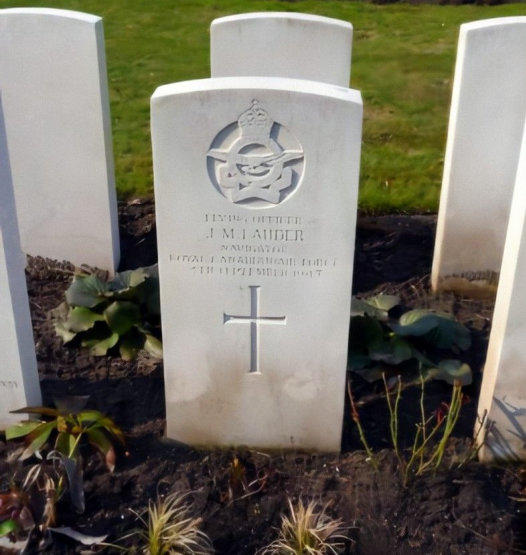
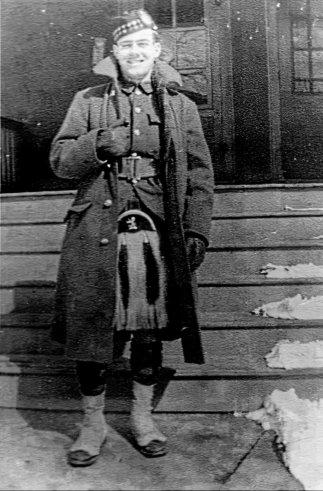
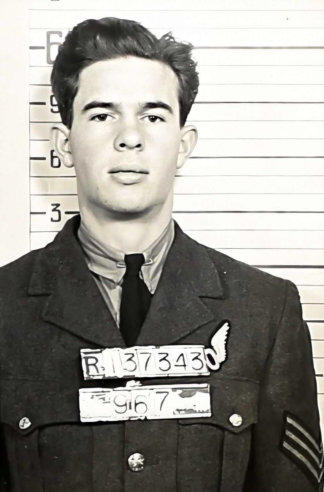
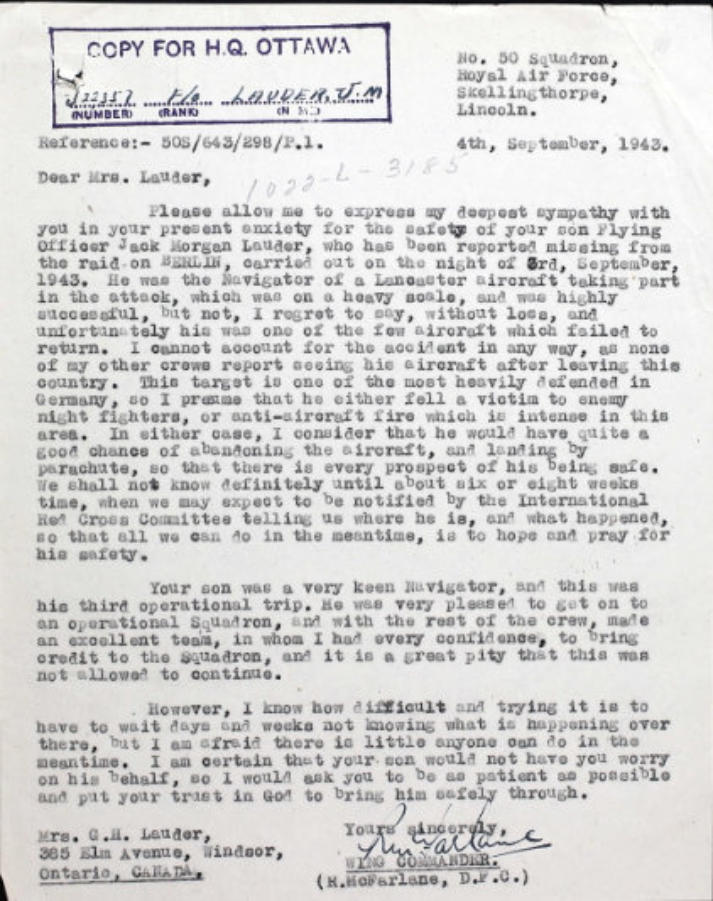
A Canadian War Story
by Harry Lauder
A father and two uncles, George, Jim, and Jack Lauder, all served in WWII, two in the RCAF and one in the Essex Scottish
Regiment (Dieppe). Only two of them returned … a story about what all three of them were doing the day the youngest
one was shot down over Berlin. The story is based on official records and the diaries of the two survivors.
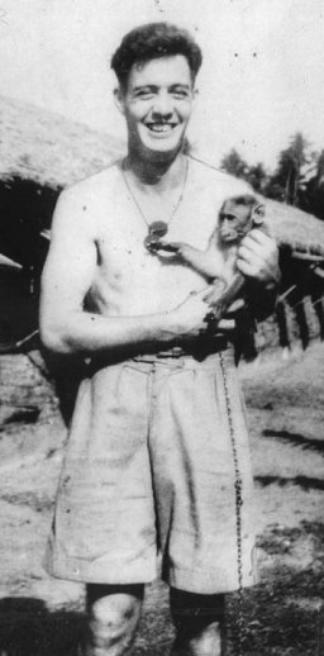


- World War I - Menu
- WWI Stories and Articles
- Photos - Yarmouth Soldiers
- Selection of World War I Songs
- WWI Casualties of Yarmouth, NS
- Those Who Served - Yarmouth, NS
- WWI Casualties Digby Co. NS
- WWI Casualties Shelburne Co. NS
- Merchant Mariners (1915) Yarmouth, NS
- Canadian Forestry Corps - Non Yarmouth Birth/Residence Enlistments
- US Draft Registry - Yarmouth NS Born


- World War II - Menu
- WWII Stories and Articles
- Telegraphist Air Gunners
- WWII Casualties of Nova Scotia
- US Casualties with NS Connection
- Far East/Pacific Casualties with NS Connection
- Merchant Navy Casualties Nova Scotia
- Nova Scotia WWII Casualties Holten Canadian War Cemetery
- D-Day Casualties - Nova Scotia
- CANLOAN Program Casualties - Nova Scotia
- Battle of the Bulge Casualties - Nova Scotia
- WWII Casualties Yarmouth NS
- Yarmouth Casualties - RCAF RAF Canadian Army WWII
- Yarmouth Co., Marrages WWII
- Casualties Non-Born/Residents with Connection to Yarmouth Co., Nova Scotia.
- WWII Casualties Digby Co., NS
- Non-Nova Scotian WWII Casualties Buried in Nova Scotia
- WWII RCAF Casualties Aged 16-18
- Brothers/Sisters Who Served - World War II













